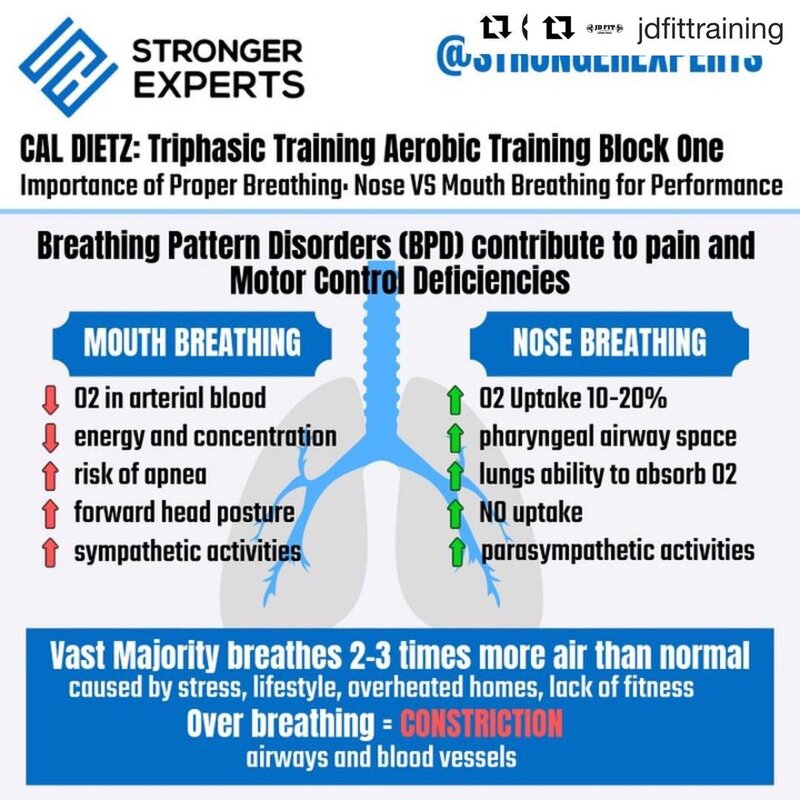|
DON’T BE A MOUTH BREATHER!
A major trend the past year with fitness enthusiasts (crossfitters) has been to include nasal breathing in their training to improve their fitness. Many people have bought into this craze without understanding the reasoning behind it. There are many reasons why it is beneficial, and I will go into further detail later on. First though, I will explain exactly how it directly improves the oxidative energy systems at a faster rate. LOW CO2 TOLERANCE: WHY WE BREATHE HEAVY When it comes to cardiorespiratory demanding activities (metcons), the ability to intake oxygen is not the limiting factor. The limiting factor is the ability to tolerate carbon dioxide in the body. When the athlete inhales, oxygen is brought into the lungs, then the blood takes the oxygen to the working muscles that need it. When the athlete exhales, carbon dioxide is expelled out of the body. As the levels of carbon dioxide in the body increase, this trigger receptors in the brain to tell the athlete to breathe more rapidly. The major point here is athletes don’t breathe more rapidly at the end of a workout to inhale more oxygen, they breathe more rapidly to get rid of the “excessive” carbon dioxide in their system. As athletes consistently only train until they reach levels of rapid breathing, the amount of carbon dioxide the body views as “excessive” will continue to decrease. The lower the tolerance level for carbon dioxide within the body, the earlier in workouts athletes will begin to rapidly increase breathing. Furthermore, the amount of oxygen that is released from the blood to be used by the working muscle is directly tied to the levels of carbon dioxide in the body. Carbon dioxide is the key variable driving the release of oxygen from the blood to working muscles. The lower the tolerance levels of carbon dioxide in the body, the less oxygen released from the blood to the working muscle. Meaning there is always plenty of oxygen available in our blood for exercise, but often it is not utilized and released due to poor carbon dioxide tolerance levels. Increasing carbon dioxide tolerance levels is very important for athletes who want to utilize oxygen efficiently and reach optimal performance. NASAL BREATHING: UTILIZE OXYGEN MORE EFFICIENTLY The first step to utilize oxygen more efficiently is increasing the athlete’s tolerance of carbon dioxide. The simplest way to do this is implementing nasal breathing in an athlete’s training. Breathing through the nose increases carbon dioxide capacity because the amount you can expel through your nose each breath is much smaller than what you can through your mouth. This in turn increases the amount of carbon dioxide in the body during exercise, resulting in more oxygen being released from the blood and the onset of rapid breathing being delayed. Just with any other training methodology, progressive overload is required to see results. At first the athlete may only be able to exercise at very low intensities and for short durations while nasal breathing. Gradually as their carbon dioxide tolerance increases, they will be able to increase the intensity and lengthen the duration of the sessions. A benefit of nasal breathing is that it is auto-regulated for each individual athlete, so exact prescription is not necessary. The pace of the training session will be based their ability to maintain nasal breathing while performing the prescribed work, if they push too hard they will know immediately as they are gasping for air through their mouth. BIGGER PUMPS Outside of increasing carbon dioxide tolerance, nasal breathing also increases the production and utilization of nitric oxide within the body. Meaning your blood vessels will be more dilated increasing the amount of blood that reaches the working muscles that need to be supplied with oxygen/nutrients. This will help your body meet the demands of high intensity exercise and make you feel better about yourself when during your next bodybuilding session. OTHER BENEFITS
HOW TO IMPLEMENT Now that you know why including nasal breathing in your training is so important here are some of the many ways to implement it.
`Personally, 1-2 times a week I perform 30-60 minutes of training via nasal breathing. I typically do it while performing monostructural work. Also, during my deload weeks I tend to do all training via nasal breathing to control intensity and actually give myself a chance to recover. I hope this was helpful, remember don’t be a MOTUH BREATHER! Work Cited: - http://vandykestrength.com/pages/utiliz_breath_train
1 Comment
Leave a Reply. |
Categories
All
Archives
February 2023
Regan QuaalHead Strength & Conditioning Coach at Shakopee High School |


 RSS Feed
RSS Feed